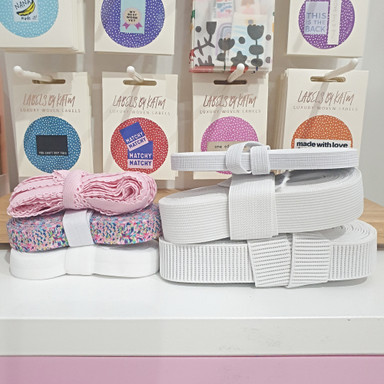Posted by Wicked Fabrics - Vivi Richards on 17th Feb 2023
Types of Elastics - What You Need To Know!
Read Time: 3m 30s
As a sewist, you will come across different types of elastics needed to complete your sewing project, but do you know what the differences are? This blog post is here to help you out, read on to discover the main types of elastics and find out what they are used for.
Knitted Elastic
Knitted elastic has a high level of stretch and is good for projects like waistbands, leg bands, and collars. It's also available in a variety of widths and colours and tends to be softer than most fabrics, so it can be worn against the skin if you choose to. The elastic maintains its width when stretched and does not narrow however, I recommend to stitch it down the centre if you are using it for waistbands so it stays in place and does not twist in the wash.
This elastic is suitable for light to medium weight fabrics, I do not recommend using it for heavier fabrics.
Non Roll Elastic
Non roll elastic is an elastic that has been designed to stay in place without rolling up or bunching. It’s usually made of polyester or nylon and it comes in a variety of widths and is commonly available in black or white. It’s often used in waistbands, cuffs, and other places where you want the elastic to stay in place and not twist on you or in the wash.
Non roll elastic is a great choice for many sewing projects because it offers a number of benefits. Here are some of the advantages of using non roll elastic:
- Comfort: Non roll elastic is comfortable to wear because it doesn’t roll up or bunch. This makes it a great choice for garments that you’ll be wearing for extended periods of time.
- Stretch: Non roll elastic is highly elastic so it stretches to accommodate different body shapes and sizes.
- Durability: Non roll elastic is very durable and can stand up to wear and tear better than regular elastic.
Fold Over Elastic
Fold over elastic is commonly known as an elastic trim that has a fold line through the centre which allows the elastic to be folded in half and sewn onto fabric. This type of elastic can be used folded over (binded look) or flat. It is available in a variety of colours and widths and is perfect for finishing off garments and accessories to give it a professional look. Some sewers like to use this as an option for making straps, headbands, and other DIY projects.
Tips for working with FOE:
- Make sure if you are stretching the FOE for your project that it is stretched evenly, by pinning it in place this will help to create a more even finish.
- It is best to use a stretch stitch on FOE, as this will allow the fabric to stretch without breaking the thread.
- If you are using FOE for straps or headbands, use a wider width of FOE for an easier and more comfortable fit.
Swim Elastic (Woven)
Woven swim elastic as the name suggests is a type of elastic used to provide support and comfort in swimwear or performance wear. It is generally made from 100% Polyester and is designed to be highly stretched and resistant to salt and chlorine.
Benefits of Using Woven Swim Elastic:
- It is highly stretchy and can conform to the body, providing a comfortable fit.
- It is durable and can withstand the rigors of swimming and other water activities.
- It is salt and chlorine resistant.
- It is available in a variety of widths allowing you to customise your swimwear.
Clear Elastic
Clear elastic is typically lightweight and nearly invisible when used in sewing projects. It is stretchy but depending on the brand, the stretch and firmness can vary. Clear elastic narrows as it stretches and is commonly used to gather and stabilise knits, modern cloth nappies, and swimwear. It is suitable for light to medium weight fabrics.
Buttonhole Elastic
Buttonhole elastic is often used in children's wear or clothing that covers a range of sizes and requires a secure fit. The elastic has evenly spaced holes along its length, the holes are designed to allow for an interior button to fit through them creating a secure and adjustable fit.
Lingerie Elastic
Lingerie elastic is a specialty elastic that has been created for lingerie garments and therefore is comfortable to be worn against the skin. Most lingerie elastics available in the marketplace are knit elastic, and does not narrow as it stretches and will not lose resiliency when sewn.
Types of Lingerie Elastic:
Some of the most common types of lingerie elastic are:
- Picot Elastic
- Bra Strap Elastic
- Lace Elastic
- Mesh Elastic
You can find lingerie elastics in a range of colours, widths and designs.
Now you know the differences between the commonly used types of elastics the next time you're looking for the perfect elastic for your project, you'll know exactly what type to choose!



